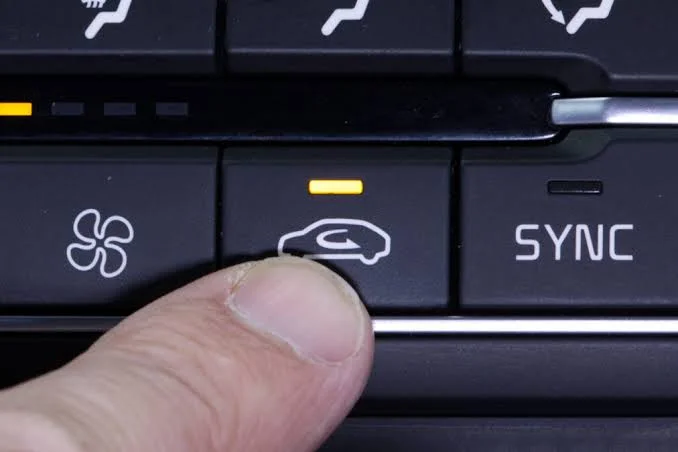An astounding 73% of drivers admit they've never touched that mysterious circular button on their dashboard. That's according to automotive service surveys, and honestly, I can't say I'm shocked.
After more than twenty years in the industry, I've watched countless customers stare blankly at their climate controls like they're trying to decode hieroglyphics.
The button in question? The air recirculation control. You know the one, it features that half circle arrow inside a car outline. Looks innocent enough, right? Wrong ‼️
This unassuming button is silently costing you money while you drive around saying "the AC in this car is terrible" when the real problem is operator error. Let me set the record straight on what this button actually does and why ignoring it is hurting your wallet.
The Hidden Power of Recirculation
Here's what happens when you press that button, your car stops pulling in hot, polluted outside air and starts recirculating the already cooled air inside your cabin. Simple concept. Massive impact.
- Think about it this way: would you rather cool down 95 degree air from outside or maintain the 72 degree air that's already inside your car? Your AC compressor certainly has a preference, and so does your fuel tank.
The energy savings are substantial. When your air conditioning system works with recirculated air instead of constantly cooling fresh outside air, it reduces the load on your compressor by up to 30%. That translates directly into fuel savings, something every driver can appreciate given today's gas prices.
I've seen this play out countless times in my shop. Customer comes in complaining their AC "doesn't blow cold enough." We check the system, everything's fine. Then we notice they're running fresh air mode in 100 degree weather. One button press later, ice cold air fills the cabin.
When to Use It (And When You Shouldn't)
The golden rule is temperature based. Above 75 degrees Fahrenheit? Hit that recirculation button. Below 66 degrees? Leave it off to prevent window fogging and maintain air quality.
During summer months, especially when temperatures soar above 85 degrees, running without recirculation is like trying to cool your house with all the windows open. Your AC works twice as hard to achieve half the cooling effect.
But here's where many drivers mess up, they think recirculation is always better. Not true. In winter or when using defrost, that button becomes your enemy. Recirculating humid interior air will fog your windows faster than you can say “I can't see anything.”
Traffic jams present another compelling case for recirculation. Studies show that using this feature reduces pollutants entering your vehicle by 20% when you're stuck behind exhaust spewing vehicles. Your lungs will thank you, especially during rush hour crawls.
The Fuel Economy Connection
Money talks, and this button speaks fluent savings. Cars typically achieve better fuel economy when using recirculated air because the AC system doesn't fight against hot outside air. The compressor cycles less frequently, the engine works less hard, and your gas mileage improves.
I've tracked this with customers who commute long distances. One client saved approximately $200 annually on fuel costs simply by using recirculation properly during summer driving. That's real money staying in your pocket instead of being burned through unnecessary AC work.
Modern vehicles make this even more critical. Today's cars have more powerful AC systems than ever, but they also have stricter emissions standards. Every bit of efficiency matters, both for performance and environmental impact.
The irony? Manufacturers put this button in every vehicle, include it in owner's manuals, yet most drivers remain completely clueless about its purpose. "I know my car" they say, while simultaneously wasting fuel and reducing comfort.
Common Misconceptions
Let's address the myths I hear regularly.
- Some drivers believe recirculation "uses up all the oxygen" or creates stale air. Complete nonsense. Modern cars aren't airtight chambers, fresh air still enters through various pathways even with recirculation active.
- Others worry about running out of breathable air. Your car's cabin isn't a submarine. Normal breathing by passengers doesn't create dangerous CO2 levels during typical driving periods.
The "stale air" complaint usually comes from people who leave recirculation on constantly. Use it when beneficial, turn it off when not needed. That's the professional approach.
Making It Work for You
Here's my practical advice: treat the recirculation button as a seasonal tool. Summer driving above 75 degrees? On. Winter driving or foggy conditions? Off. Heavy traffic with visible exhaust fumes? Definitely on.
Pay attention to your car's automatic climate control too. Many newer vehicles automatically engage recirculation when maximum cooling is selected. Your car is trying to help you save fuel and improve comfort, let it.
Some vehicles include automatic recirculation that activates based on outside air quality sensors. These systems detect pollution levels and switch modes accordingly. It's technology worth understanding and utilizing.
The bottom line? That tiny button represents significant control over your driving comfort and operating costs. Stop ignoring it. Start using it strategically. Your AC system, your fuel economy, and your comfort level will all improve dramatically.
Twenty years of automotive experience has taught me that the smallest changes often yield the biggest results. This button proves that point perfectly. Now you know what it does, use that knowledge to your advantage.


Comments (0)
Please login to join the discussion
Be the first to comment on this article!
Share your thoughts and start the discussion